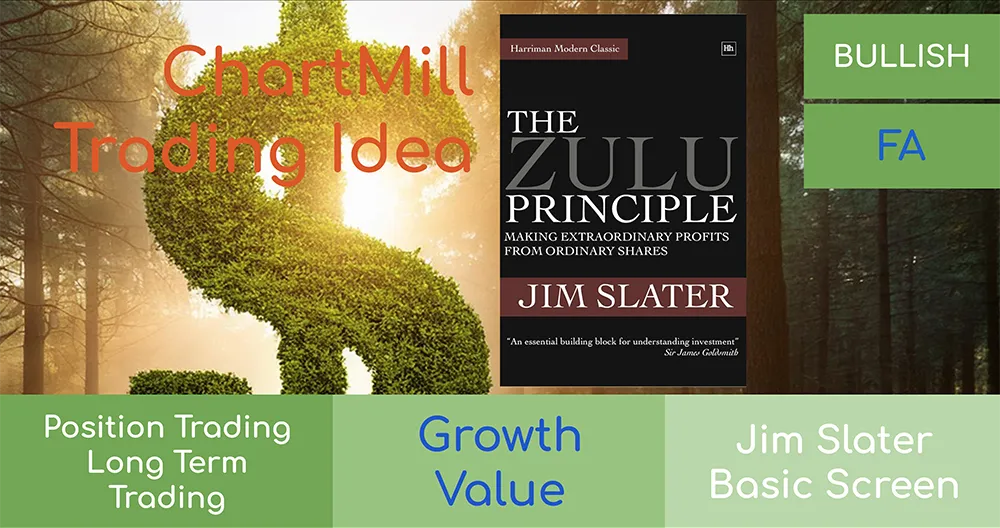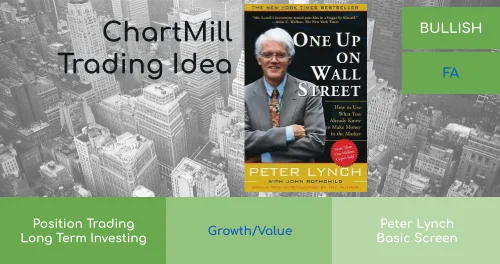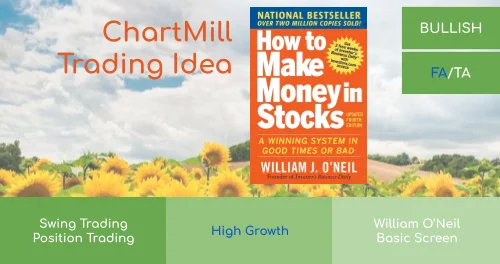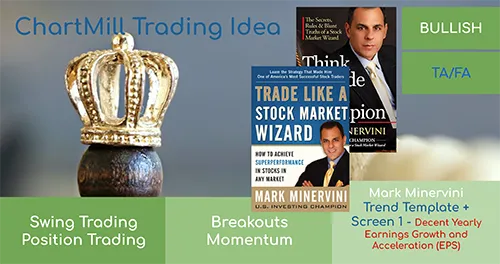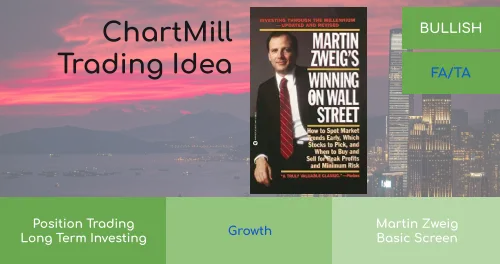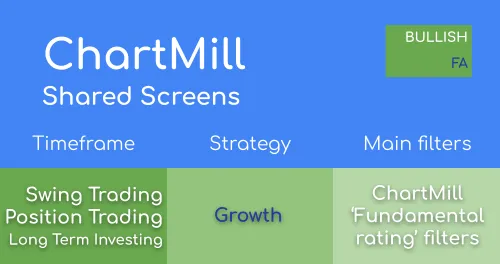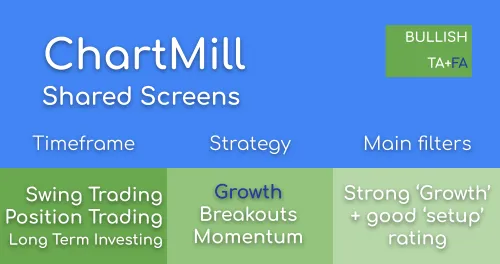Louis Navellier's Little Book That Makes You Rich – Screener Settings
By Aldwin Keppens - reviewed by Kristoff De Turck
Last update: Jul 22, 2024

The little book that makes you rich is a book written by Louis Navellier in 2007. As we can find in the description on Amazon:
The Little Book That Makes You Rich is the latest book in the popular "Little Book, Big Profits" series. Written by Louis Navellier -- one of the most well-respected and successful growth investors of our day -- this book offers a fundamental understanding of how to get rich using the best in growth investing strategies.
We also have this book in our collection and it really is a ‘little’ book in the (positive) sense that you can very quickly read through it. Another positive thing is that already on page 4 Navellier describes the 8 rules he uses for selecting superior growth stocks and in the rest of the book each of these rules are explained in more detail. As we have everything available to filter based on these rules in ChartMill, we decided to create a shared screen in our trading ideas library for this.
We will go over these rules below and describe how they can be translated into filters for the stock screener.
Please make sure to understand: this screen serves as an example and a starting point. You are encouraged to play around with the settings by for instance tightening or loosening the filters which are set according to your own insights. You are also encouraged to read the book for full and detailed insights on why these rules matter.
The 8 rules
These are the 8 rules used in the book, we will discuss them one by one below.
- Positive Earnings Revisions:
- Positive Earnings Surprises.
- Increasing sales growth
- Expanding Operating Margin
- Strong Cash Flow.
- Earnings growth
- Positive Earnings Momentum.
- High return on Equity.
1. Positive Earnings Revisions.
Wall Street analysts provide estimates for the EPS and revenue they expect the company to report in the upcoming quarters and years. An analyst who consistently overestimates these numbers will not be appreciated very much and this will weigh on their reliability perception. At the same time analysts who underestimate are not punished as hard for this. Therefor, in general, you can expect analysts to be rather conservative. When one or several analysts start to revise their estimate to the upside, you can assume they have strong indications to do so. And this is exactly why we should consider these upward revisions as a positive sign.
Our stock screener has several filters related to revision available. We added a filter which requires the EPS estimate for the next quarter to have been raised by at least 4% in the last 3 months.
2. Positive Earnings Surprises.
Companies which manage to exceed the expectations of analysts and are able to do so time after time will force analysts to review their future estimates, which will drive up the total future expected profits and hence the price.
Our stock screener has many filters available which are related to EPS (and revenue) surprises. For the example screen, we require at least 3 positive EPS surprises in the last 4 reports and the average surprise to be above 10%. More is always better, but we like to set the screening criteria not to tight and the last step is always a careful manual evaluation of the results.
More in-depth information on earnings surprises can be found in this article: "Earnings Surprise Explained"
3. Increasing sales growth.
A growth stock needs to grow and one of the ways to measure this is to check whether it is actually selling more than in the past. Year over year sales and quarter over quarter sales should show significant advances. On top of that, we ideally want sales to be accelerating.
We are adding the following rules to our screen: At least 20% Y2Y revenue growth and At least 20% Q2Q revenue growth. Note that the Y2Y growth will compare the last Trailing Twelve Month (TTM) year to the previous.
We did not add a filter for the acceleration part, but there are several options to do so: you can add a filter comparing the current Q2Q to the previous Q2Q, or compare the most recent growth to the past 3 or 5 year growth.
For those seeking a more streamlined approach, the ChartMill High Growth Momentum Rating combines several key metrics, including quarterly and yearly acceleration, to identify stocks with robust growth potential and momentum.
4. Expanding Operating Margin
It is a good sign when the company is able to increase its profitability. The operating margin compares the operating income to the sales. As we have sales increasing, it is a good sign if the company can do this without increasing the costs in the same proportion.
For this condition we added a rule to our screen requesting that The operating margin has grown with at least 2% in the past year
5. Strong Cash Flow.
Free Cash Flow is the actual cash which remains after the company did all of the necessary expenses to keep the business going. Producing free cash flow gives options to the company and also makes sure it can finance its own growth.
To check this we added a rule to our screen requiring The Free Cash Flow Growth in the past year to be at least 15%.
6. Earnings growth.
Next to pure revenue growth, we also want to see the reported Earnings Per Share to show decent year over year and quarter over quarter growth.
To meet this requirement we added these filters: At least 15% Y2Y EPS growth and At least 15% Q2Q EPS growth
7. Positive Earnings Momentum.
Earning momentum requires the earnings to be accelerating. So we want to see a higher Q2Q growth in the last quarterly report than we did in the report of the same quarter last year (which compared to the same quarter 2 years ago).
To follow this rules we used a custom expression in our screener which requires the current Q2Q EPS growth number to be above the previous Q2Q number.
8. High return on Equity.
The company should produce a high return on equity, which means it is able to generate profits on the cash invested by shareholders.
In our screen we require A minimum ROE of 10%. The author also mentions that he likes to see ROE improving. When you evaluate the results of the screen make sure to check out the balance sheet on the financials tab of the profile pages for the stock. Here you can nicely see the ROE numbers for each of the past years.
Additional notes.
First we restate that for a full understanding on why these rules were used you should read the book. The author also states that different market environments favor different weights of the rules: in some market conditions positive earning surprises will be rewarded more, while sometimes improving return on equity will perform better. This is just an example, but the point is you can monitor what works best in the current market conditions by watching all of these stocks and see which ones perform best.
The screener configuration only uses fundamental analysis criteria and finds stocks for growth investing. Because of this it is typically associated with position trading or long term buy and hold. Probably buy and hold is just a bit too much and the growth investor will keep an eye on the growth parameters and consider regularly whether the stock should be held or not.
The screen uses exclusively short term fundamental ratios. This was done on purpose to allow early discovering of newer growth companies. The oldest parameter used in the screen is the EPS for the last quarter 2 years ago, which is used to measure the EPS growth acceleration. All other numbers are current, Y2Y or Q2Q growth numbers. When you would like to look at companies with a longer track record, you can include some longer term filters.
All applied filters are on effectively published result, so it only looks at past performance. Our stock screener offers many options to check the future estimated growth numbers (eps, revenue, ebit). However: you always need to be a bit careful when adding these as it may be analysts have not updated their estimates yet or there simply are no analysts following the stock.
Finally, as the growth investor looks for explosive price growth, this screen may also be very interesting for swing traders who just want a shorter ride, but look for momentum. A very simple way to find setups in this list is to add a filter requiring the ChartMill Setup Value to be above 6 or 7 and change the view to ‘charts’.
We would like to refer again to our ChartMill High Growth Momentum Rating Score which is specifically designed to detect these types of stocks.










